Introduction: fear of witches
From the 1500s to the middle of the 1700s, nearly four thousand Scottish people were put on trial for witchcraft. Many were found guilty and executed.
What is witchcraft, and why were people so scared of witches?
Watch: Superstitions and folklore
In this video, learn about the story of Alison Pearson of St Andrews and the superstitions, folklore, magic, and witchcraft that people in this age believed in
Saltwater for curing wounds, butter to heal the skin, red nettles to cure pain in the loins. Just some of the methods used for centuries by folk healers like Alison Pearson of St. Andrews.
In 1583, she treated a sickly Patrick Adamson, Archbishop of St. Andrews. She had concocted for the archbishop a beverage of ewe’s milk, claret, and herbs which led to his full recovery.
“Suspicious!” cried Adamson’s rivals. “She’s a witch!” Poor Alison was imprisoned on charge of witchcraft, sealed in St. Andrew’s castle. And Adamson himself helped her escape imprisonment.
But at a time of fear and changing opinions on witchcraft, a woman like Alison wasn’t safe for long. And in 1588, she was captured once again, executed and her body was burned. One of thousands of innocent lives lost across Scotland.
How did so many innocent people like Alison find themselves embroiled in a Scotland-wide witch hunt?
Folk customs and belief in magic existed across the world for centuries. In Western Europe, witches were both respected and feared for their powers.
Folk beliefs like curing the sick from evil spirits by filling a bottle with a sick person’s urine along with nails and hair, the bottle was then buried to trap the evil spirits.
And, for a long time, these folk customs sat rather uncomfortably next to Christian views. It wasn’t until the tent century that the Catholic Church had decided witches had in fact been fooled by the Devil into thinking they had magical powers.
And by the 1400s, the church believed quite sincerely that witches could channel the Devil and it was the devil that was behind the world’s evils. We’re talking curses, controlling the weather, and covens where animals, and even humans, were sacrificed.
And over time, the church began to take a tougher stance on folk’s beliefs. The Pope’s decree on witchcraft in 1484 encouraged correcting, imprisoning, punishing, and chastising those involved in witchcraft. Because, as he put it, those straying from the Catholic faith have abandoned themselves to devils.
And so innocent people like Alison Pearson became particular targets. As you’ll remember, she was a healer who used herbs and traditional treatments, but because there was little understanding of how healers worked, people started suspecting that magic was involved. This cast them in danger for fear of being in league with the Devil.
Any activity that was at odds with the Church of Scotland brought on suspicion and local healers were seen as a threat to be removed, and women were the most frequent victims.
In Scotland, 84% of the accused were women. Ultimately, it was Alison and those like her who paid the price for the Scottish authorities' fight against witchcraft and the Devil.
Did people always fear witches?
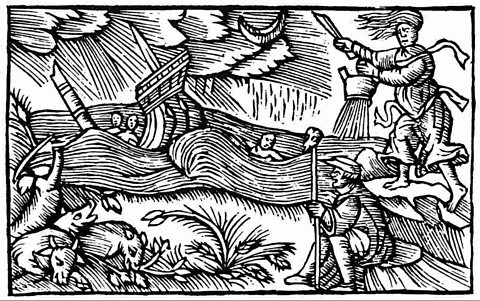 Image source, ALAMY
Image source, ALAMYBelief in magic has existed for thousands of years across civilisations around the world.
Magic was often seen as a part of the natural world. Some people seemed able to put magic to use. In some cultures magic was seen as a special power that only some people had. In other cultures, using magic was something that could be learned and practised.
Using magic was not seen as either good or bad but it could be put to either good or bad purposes. So someone who could perform magic was not necessarily someone to fear.
Magic to help and heal
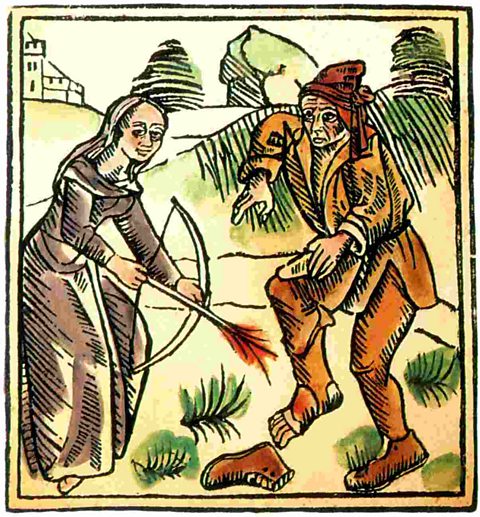 Image source, ALAMY
Image source, ALAMYIn the past, people had a much more limited idea of illness and the body than we do today. When they were ill, they might turn to a healer for help.
Healers might have made potions using herbs and other plants that did have real medical benefits, or someone might really feel better because they believed that they had been cured, but at the time it was believed that magic was responsible for healing the sick. Use of spells, talismans, charms and potions were all seen as real ways to overcome illness.
But being a healer was only a good thing if the healing worked.
Jonet Tailzour
In 1633, Jonet Tailzour was a healer near Alloa. Local people turned against her when they thought some of her cures had failed, or when illnesses seemed to transfer to other people or animals.
Jonet was found guilty of witchcraft by Stirling Burgh Court and banished from the community. She was later tried again, found guilty and executed.
 Image source, ALAMY
Image source, ALAMYMagic to harm
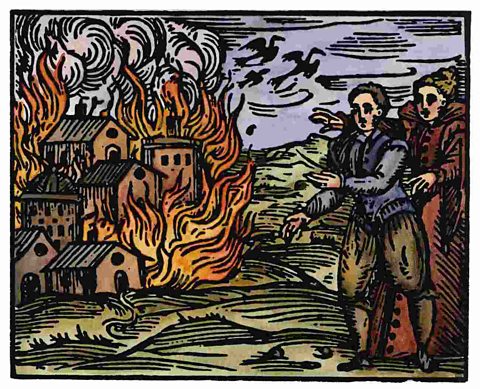 Image source, ALAMY
Image source, ALAMY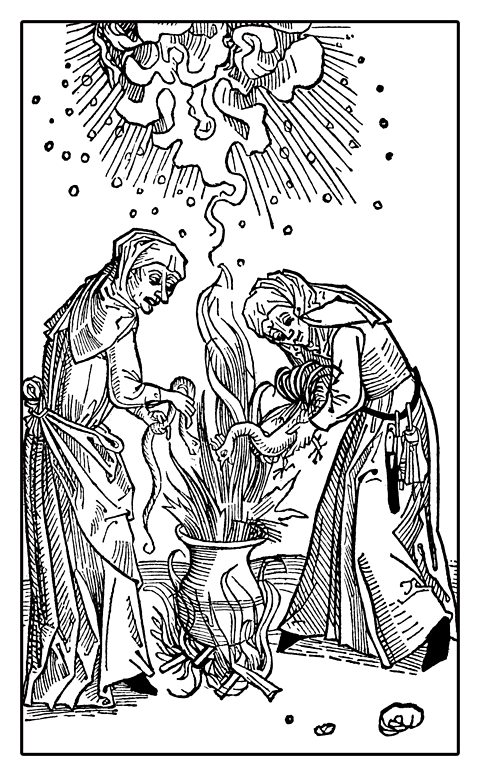 Image source, ALAMY
Image source, ALAMYJust as magic could be used to heal the sick, it was also believed that magic could be used to harm or even kill other people, or to damage their property.
If someone who was involved in an argument, or a member of their family became ill, or suffered some misfortune, it was believed that this could be the result of a curse or other harmful magic.
For example, in 1634, Elizabeth Bathgate argued with a weaver called George Sprott. Bathgate was said to have sold the family enchanted eggs, one of which caused Sprott's child to develop a egg-sized swelling and later die. She was later found not guilty.
The main signs of witchcraft were illness, or bad luck. Witches were believed to have power over the natural world, so failing crops, sick livestock, or ever bad weather could all be seen as the result of witchcraft.
At a time when most people lived off of the land, any of these problems could result in a family being unable to feed and support itself.
 Image source, ALAMY
Image source, ALAMYWhether they used magic to help or to harm someone, people who performed magic were part of their community. Witches used magic to help those they liked, or who paid them, and used it to hurt those they fell out with.
Isobel Cockie
For example, in 1597, Isobel Cockie was accused of witchcraft after a neighbour was unable to churn their milk to make butter. She was also accused of cursing a neighbour after a dispute about who owned a house.
During her trial, it was noted that she had been paid as a healer, having given a man a drink made of herbs, butter and saffron to take three times a day.
For the most part, people tried to resolve problems they had with witches. The worst punishment a witch would usually face was being banished from the community.
Do you think ordinary people feared witches?
Why do you think this?
People don't seem to have completely feared witches:
- many people turned to witches and 'good magic' to help them if they were ill
- people who thought they had been cursed might ask another witch to use magic to protect them
This suggest that some people trusted some witches at least some of the time.
But
- people genuinely thought that witches could do harm with magic
- the thought that a witch could damage food, animals or crops, make you ill or even kill you must have been very scary
People were probably scared of witches' powers and what they might do with them. They probably felt they had to be careful not to cross a witch who might do them harm.
Witchcraft and the Devil
 Image source, ALAMY
Image source, ALAMYBeliefs about what witchcraft involved changed over time. By the 1500s, organised Christian religion had decided that witchcraft and magic were evil and that witchcraft involved making a pact with the Devil.
In Christian countries like Scotland, the Devil terrified people more than anything else.
Rulers and leaders feared for themselves and the spiritual health of their countries. King James VI of Scotland was convinced that witches had plotted to kill him.
Ordinary people feared for their own lives, their livelihoods and wellbeing.
Witches sabbath
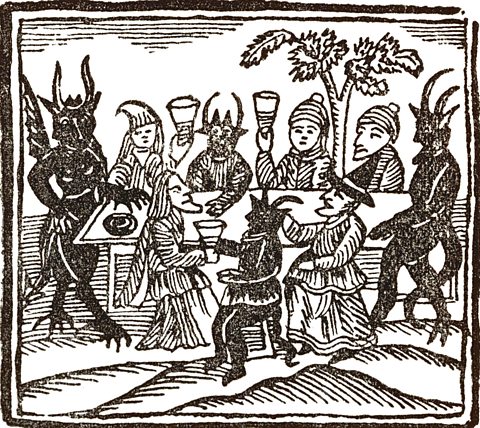 Image source, ALAMY
Image source, ALAMY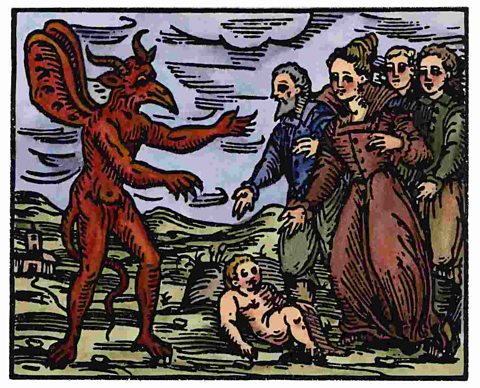 Image source, ALAMY
Image source, ALAMYAt these events, some believed that there were animal or even human sacrifices, with innocent victims offered to the Devil.
In Scotland, children, especially those who had not been baptised, were seen as being in particular danger.
 Image source, ALAMY
Image source, ALAMYTest your knowledge
More on Scottish witch trials
Find out more by working through a topic
- count6 of 7
